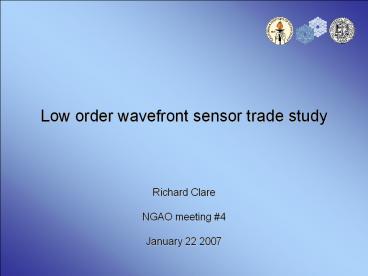Low order wavefront sensor trade study - PowerPoint PPT Presentation
1 / 16
Title:
Low order wavefront sensor trade study
Description:
First 6 Zernike orders considered, only tip/tilt errors are evaluated ... Limiting magnitude is chosen to be 19 for all spectral bands. At zenith. Read noise = 10 e ... – PowerPoint PPT presentation
Number of Views:24
Avg rating:3.0/5.0
Title: Low order wavefront sensor trade study
1
Low order wavefront sensor trade study
- Richard Clare
- NGAO meeting 4
- January 22 2007
2
Outline
- Background on sky coverage simulator
- Assumptions and parameter set chosen for NGAO
- What spectral band should we use for the LOWFS?
- How many LOWFS do we need?
- What modes should the LOWFS measure?
- What is the sky coverage for different science
cases? - What is the effect of the LGS asterism radius on
partial correction and sky coverage?
3
Modeling overview
NGS at infinity generated with guide star
statistics (Bahcall-Soneira, Spagna models)
Sodium LGS at 90km
a(3)
Discrete layers of turbulence, described by
Zernikes, a.
a(2)
a(1)
- Calculate transformation matrices from
- LGS, NGS, science points to aperture
4
Simulator methodology
- Calculate atmospheric tip/tilt error with minimum
variance estimator from transformation matrices
and covariance matrices of atmosphere noise - Optimize sampling frequency to balance servo lag
and noise - Choose combination of NGS that gives lowest total
error - Monte Carlo over many NGS constellations
- Generate cumulative density functions of
performance
5
Checking against an AO Simulation
- Compare to LAOS for 4 asterisms for an 8m
telescope with no windshake, no sodium tracking
error, integrator control, and 10 phase screens
for each asterism - Generally good agreement, but LAOS results
somewhat poorer with noise
Median tip/tilt error (nm) Median tip/tilt error (nm) Median tip/tilt error (nm) Median tip/tilt error (nm)
Asterism LAOS without noise Sky cov. without noise LAOS with noise Sky cov. with noise
Good (equilateral) 719 58 11511 842
25th percentile 7613 86 889 1190
Median 10616 114 20015 1785
75th percentile 19233 221 48052 3344
6
Simulation Parameters/Assumptions
- Finite outer scale (75m)
- Mauna Kea (7 layer) turbulence and velocity
profile - First 6 Zernike orders considered, only tip/tilt
errors are evaluated - Detector pixels are seeing-limited in V band (0.5
arc sec) - and diffraction-limited in J/H/K bands (? /D
rads) - NGS are partially corrected in J/H/K bands. Not
in V band. - Integral control with g0.5
- 7 LGS asterism (1 on-axis, 6 in a ring) Ralfs
asterism 7a - LGS measurements are noise-free
- Limiting magnitude is chosen to be 19 for all
spectral bands - At zenith
- Read noise 10 e
- Run over 500 NGS constellations
7
Median Field of View
Field Galaxies case Latitude30 deg
J17.1
J16.4
J17.4
J16.6
J19.0
J18.7
8
Example Cumulative Density Function
Field Galaxies science case J band
30th percentile107nm
Errors are in nm. 1 mas 12.1 nm for a 10m
telescope
9
Choice of Spectral Band
As ? increases, tip/tilt estimate
- Trade-off between
- Partial correction
- Sky background
- Zeropoint (number of photons)
- Spot size
10
Spectral Band
Errors are in nm. 1 mas 12.1 nm for a 10m
telescope
Tip/tilt error (nm) Tip/tilt error (nm) Tip/tilt error (nm)
Spectral band 10th percentile Median 90th percentile
V 198 326 1140
J 80 131 221
H 78 127 212
K 99 161 261
For field galaxies science case and 1 TTFA 2TT
sensors
11
NGS Patrol Field Diameter
For field galaxies science case, J band, and 1
TTFA 2TT sensors
12
LOWFS number order
Errors are in nm. 1 mas 12.1 nm for a 10m
telescope
Tip/tilt error (nm) Tip/tilt error (nm) Tip/tilt error (nm)
LOWFS 10th percentile Median 90th percentile
1 TT 152 209 359
1 TTFA 125 215 312
3 TT 90 146 263
1 TTFA 2TT 80 131 221
TTtip/tilt (ie 1x1), TTFAtip/tilt/focus/astigmat
ism (2x2)
For field galaxies science case, and J band
13
Different science cases
- Three science cases chosen from NGAO proposal
- Science cases have different higher order error,
galactic latitude and science field size - Goods N (218 nm, 45 deg, 1.09 arc min)
- Narrow Field (86 nm, 10 deg, 0.178 arc min)
- Field Galaxies (173nm, 30 deg, 0.7 arc min)
14
Degree of partial correction
- Partial correction depends on LGS asterism radius
and higher order error from science case
Goods N (218nm)
Field galaxies (173nm)
Narrow Field (86nm)
15
Median results for science cases/asterisms
Errors are in nm. 1 mas 12.1 nm for a 10m
telescope
Median tip/tilt error (nm) Median tip/tilt error (nm) Median tip/tilt error (nm)
Science Case LGS radius 7.2 LGS radius 21.6 LGS radius 35.9
Goods N 317 284 277
Narrow Field 116 96 94
Field Galaxies 156 131 127
16
Conclusions
- IR WFS (either J or H) is preferable to visible
- Multiple NGS WFS significantly improve tip/tilt
estimate - Measuring focus with 1 of the tilt sensors also
helps - A wider LGS asterism improves partial correction
over the field and hence sky coverage































